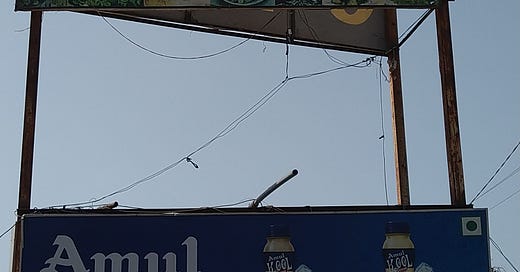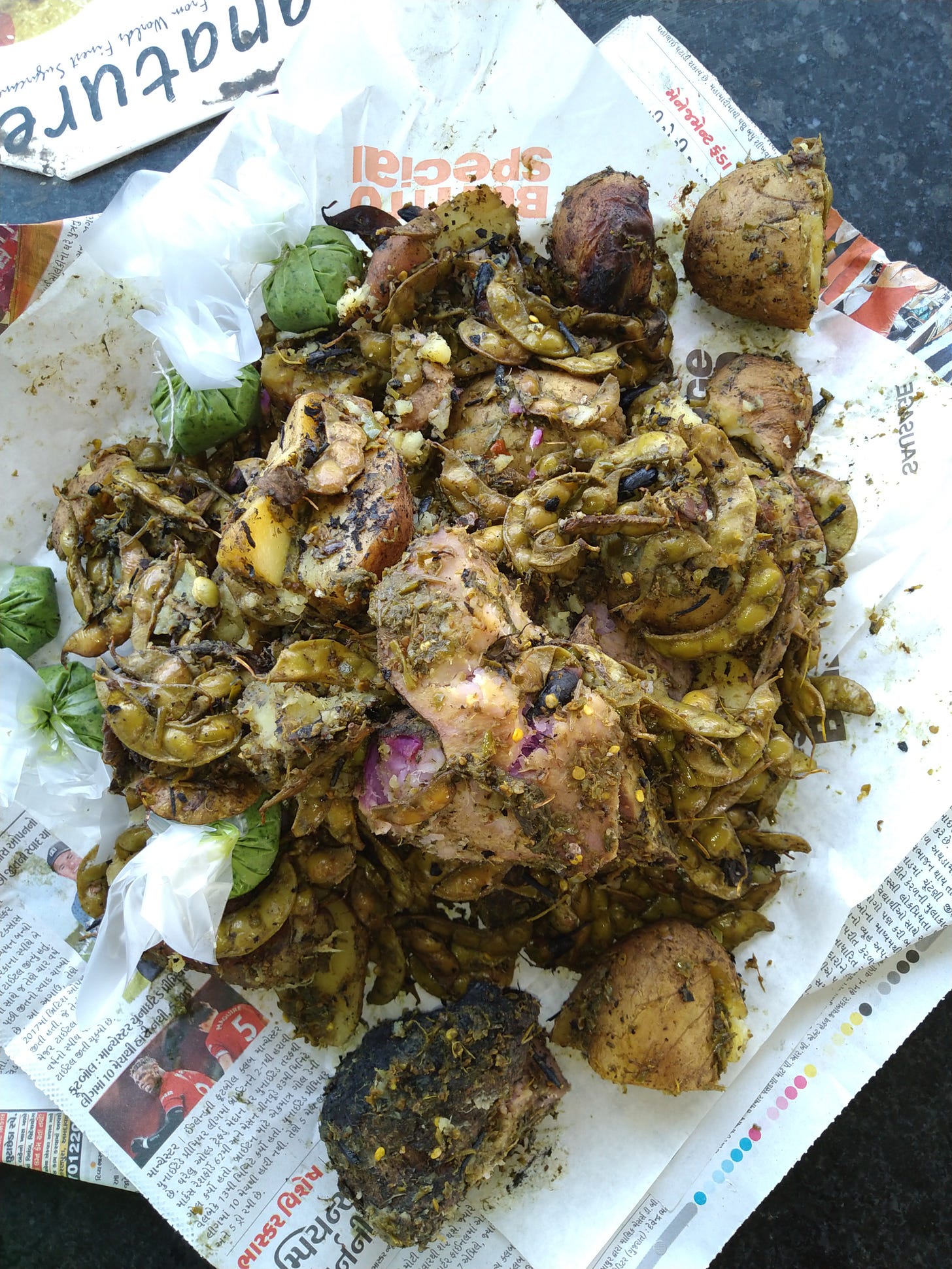On the trail of Umbadiyu - Valsad’s winter delicacy
Similar to the Surti Undhiyu, Umbaidyu is Gujarat’s vegetable barbecue
The Mumbai Ahmedabad highway is a food lovers’ destination not just for the restaurants that dot it but seasonal specialties that spring up periodically. So while in summer, you can find stalls that sell the famous Kesar mango, in winter, you can find kitchens spring up to serve the delicious Umbadiyu.
You can find Umbaidyu restaurants along with the NH 48 close to Valsad and, more specifically, Dungri. You can easily spot numerous Umbadiyu kitchens cluster around Dungri and recognize them through their open fires with upturned matlas (clay pots) slow cooking the dish. Most such restaurants have thatch roofs, are open at the sides, and serve just one dish, Umbadiyu, all day and night, attracting eager crowds.
One holiday in January of 2022, we drove 188 kilometers from Urbania to eat at one famous restaurant, Babhubhai nu Umbadhiyu (Babubhai), with more than two thousand Google Maps ratings! My friend Preeti Desai of Navasari guided us to this restaurant when we asked her for a place that serves Umbadiyu. She also accompanied us and helped us order and learn about this amazing one-pot dish.
Though we set out early morning to Babubhai’s restaurant, we reached there only afternoon due to the holiday traffic on the highway and the slow down your experience at the three toll plazas and one highway construction zone near Vapi. The four-hour drive was the only difficult part of our trip.
When we arrived at Babubhai, the restaurant was not serving the dish as they had run out of the quantity they had cooked till our arrival. So, waiting for a fresh Umbadiyu batch in cooking at an open fire outside the restaurant, we learned from Preeti Umbadiyu ingredients and recipe.
Winter vegetables like potatoes, purple yam, hyacinth beans (Val papdi), field beans (papdi), and sweet potato are common Umbadiyu ingredients. The papdi must be tender for use in the dish, and thus its immature form is what goes in for the ingredients. However, like with every Indian dish, there are numerous Umbadiyu variants, some with brinjal and others with muthiya. In addition, some recipes have marination of the brinjal as part of the cooking process.
The green paste that you find in Umbadiyu has coriander, ginger, and chilly, apart from salt. Making Umbadiyu involves marinating the cut vegetables (other than the beans) with the mixture and leaving it to seep into them for some time.
For cooking, Umbadiyu makers layer clay pots with the marinated ingredients starting with the beans at the bottom and the harder ones like potatoes, sweet potatoes, and yams in between, ending with a layer of beans at the top.
Umbadiyu’s smoky flavor is linked to local weeds that its makers use at the top to close the mouth of the clay pots. At the mouth of a clay pot filled with Umbadiyu ingredients, the makers put chopped kalhar (Indian nettle), kamboi (black honey shrub), and lemon leaves. Some Umbadiyu variants have chopped weed leaves interspersed within the different layers.
Cooking Umbaidyu involves leaving the clay pots with the raw dish on mounds with slow fires from locally available sugarcane stalks, dried mango leaves, dried coconut leaves, and dried cow dung cakes. Then, as you wait in line at the Umbadiyu stall, you can watch the restaurant staff haul in fresh pots of ingredients for the nearly one-hour slow cooking of the dish. Then, restaurants empty the freshly cooked dish into hot packs to serve the eager diners waiting for their turn of the dish.
You buy Umbadiyu by weight paying about two hundred fifty rupees a kilogram with small packs of green coriander chutney. After that, you get Umbadiyu in disposable plates wrapped in aluminum foil and newspaper and finally in plastic bags. You can eat the dish at the open at the sides restaurant itself which provides tables and chairs. Most Umbadiyu restaurants also have kiosks that serve buttermilk that diners consume.
Generally, you eat Umbadiyu without any other accompaniment! You don’t even need to remove the skin on the sweet potatoes, potatoes, and the purple yam. However, you will likely find charred portions of the purple yam, which, being low in moisture, may sometimes come out overcooked from the pot. The more difficult part of the dish is the papdi you need to skin to get to the beans! You will spend a lot of time peeling the beans and reaching their interiors for the edible part.
Families and groups enjoy Umbadiyu in communal eating! Everyone takes part in the order and eats it after removing the bean skins!
Umbadiyu has no water or oil to aid its cooking with the wood fire heat using the moisture inside the ingredients to cook them. As some vegetables like purple yam are low in moisture, you may find their chunks overcooked or charred when you consume them.
Dungri is the location near Valsad, which has numerous Umbadiyu stalls in winter, with each stall having small groups of people to partake of a winter delicacy.
There are a few other things when you go to Dungri. Before you reach Babubhai, you will find a Balaji Wafers factory on your left where the brand sells its famous products. You can buy the branded ones at a discount to retail prices and choose from bulk one-kilogram packs from their popular potato chips and other snacks.
The Sugar N Spice highway rest stop has a large restaurant, an ice cream shop, a pizzeria, and other stores. It is a good place for access to clean washrooms and has plenty of parking space around it. You can also try their undhiyu dish, which they advertise and serve in winter in an air-conditioned ambiance at their multi-cuisine restaurant.
If you are looking for an outing this winter, I recommend the Umbadiyu shacks of Dungri, which spring up to serve a seasonal delicacy that you can’t find anywhere else in India.
Happy travels and Bon Appetit.




